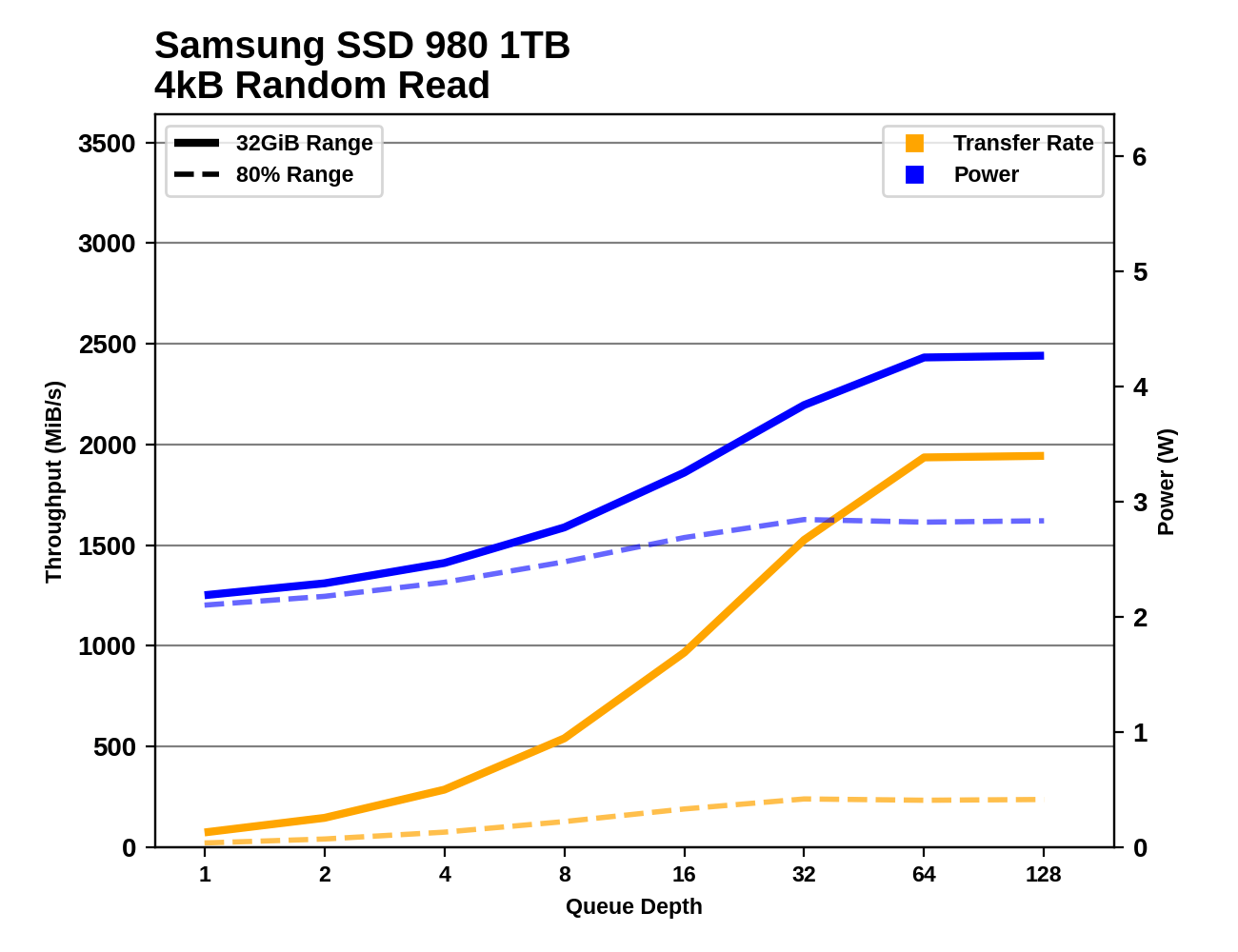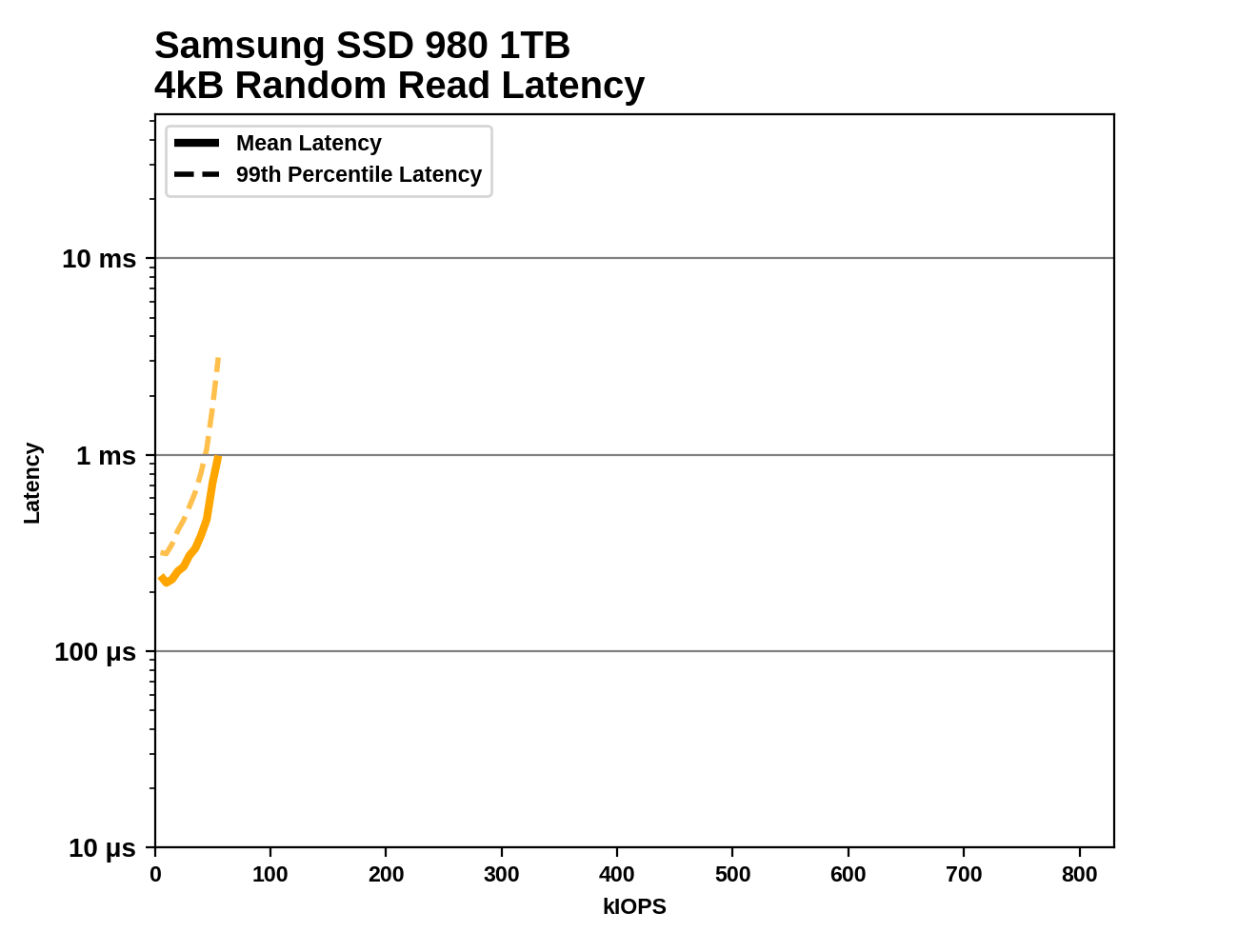The Samsung SSD 980 (500GB & 1TB) Review: Samsung's Entry NVMe
by Billy Tallis on March 9, 2021 10:00 AM ESTBurst IO Performance
Our burst IO tests operate at queue depth 1 and perform several short data transfers interspersed with idle time. The random read and write tests consist of 32 bursts of up to 64MB each. The sequential read and write tests use eight bursts of up to 128MB each. For more details, please see the overview of our 2021 Consumer SSD Benchmark Suite.
 |
|||||||||
| Random Read | Random Write | ||||||||
| Sequential Read | Sequential Write | ||||||||
Given that the Samsung SSD 980 is a DRAMless drive with aggressive SLC caching, it's no surprise to see that most of the burst IO scores show a big difference between testing a small slice of a mostly-empty drive and testing across an 80% full drive. The test runs with the NVMe Host Memory Buffer feature disabled also show how important that is to enabling random IO performance. In the best cases, the SSD 980 even manages to deliver better QD1 random read performance than the 980 PRO. However, when testing against a large data set (or with HMB disabled), the SSD 980's performance only remains competitive for sequential reads. For the other IO patterns, its performance drops far more than typical for entry-level drives.
Sustained IO Performance
Our sustained IO tests exercise a range of queue depths and transfer more data than the burst IO tests, but still have limits to keep the duration somewhat realistic. The primary scores we report are focused on the low queue depths that make up the bulk of consumer storage workloads. For more details, please see the overview of our 2021 Consumer SSD Benchmark Suite.
 |
|||||||||
| Random Read | Throughput | Power | Efficiency | ||||||
| Random Write | Throughput | Power | Efficiency | ||||||
| Sequential Read | Throughput | Power | Efficiency | ||||||
| Sequential Write | Throughput | Power | Efficiency | ||||||
When testing under favorable conditions with a small data set, the SSD 980's performance is at the very least competitive with other entry-level NVMe SSDs and sometimes against mainstream drives as well, but it falls apart too easily. Performance on the sustained IO tests shows similar behavior to the burst IO tests with generally quite large performance drops on the SSD 980 when testing is not constrained to a small data set. Bringing in some moderately higher queue depths has helped the sequential write performance catch up somewhat when testing against an 80% full drive.
 |
|||||||||
| Random Read | |||||||||
| Random Write | |||||||||
| Sequential Read | |||||||||
| Sequential Write | |||||||||
When running the sustained IO tests against a 32GB range of the drives, the Samsung SSD 980 shows good performance scaling with increasing queue depths and can eventually achieve quite high throughput. Random reads take a long time to reach full speed at QD64, while random writes and sequential reads saturate around QD8 and sequential writes saturate at QD2. But testing on a wide range of a mostly-full drive reveals lots of problems: random reads and writes are very slow even at extreme queue depths, and the sequential write test frequently overruns the SLC cache.
Random Read Latency
This test illustrates how drives with higher throughput don't always offer better IO latency and Quality of Service (QoS), and that latency often gets much worse when a drive is pushed to its limits. This test is more intense than real-world consumer workloads and the results can be a bit noisy, but large differences that show up clearly on a log scale plot are meaningful. For more details, please see the overview of our 2021 Consumer SSD Benchmark Suite.
 |
|||||||||
This random read latency test paints a pretty bleak picture for the Samsung SSD 980: every other drive in this bunch has lower latency and higher throughput, and the 500GB 980 actually does slightly better than the 1TB. This test is covering 80% of the drive so HMB is no help here, but that applies to the other DRAMless NVMe drives as well.










54 Comments
View All Comments
WaltC - Tuesday, March 9, 2021 - link
Trying to fathom what "retail-ready" means...;) All of my Samsung NVMe drives--yes, even those with "pro" and "evo" in the names--were purchased at retail. Why is this drive anymore "retail-ready" than a 980 Pro, for instance, also sold at retail. Perhaps you meant to say, Samsung's "value drive," or "low-cost NVMe segment," etc, as it is no more "retail-ready" than any of Samsung's other drives--which are all sold at retail.WaltC - Tuesday, March 9, 2021 - link
I did see the "entry-level" qualifier, however. But I'm not aware that Samsung has ever manufactured an SSD that was not "retail-ready."linuxgeex - Tuesday, March 9, 2021 - link
Along with "entry-level"... Anandtech really should have benchmarked this drive on a dual-core 6th gen laptop or 8th-gen 1L desktop minipc, because that's the kind of devices this is going to land in. And using the host memory for the cache and the extra driver bloat is going to hurt those weak machines. I am certain that a SATA M.2 with DRAM would end up outperforming this for most of the actual retail customers. Where this is a fabulous deal is in HEDT machines that want a lot of cheap SSD storage to act as front cache for a RAID, because they have RAM and cores to spare, so the loss of a relatively piddling amount of RAM to the host cache and driver bloat when they have 16-32x the RAM, isn't such a big deal.Billy Tallis - Tuesday, March 9, 2021 - link
I think you're vastly overestimating what's involved in making HMB work. It's a straightforward feature for the host OS to support and does not "bloat" the NVMe driver. Allocating a 64MB buffer out of the host RAM is a drop in the bucket, or: two frames of 4k image data. The SSD will only touch the HMB a few times per IO, plus maybe a bit more often when doing heavy background operations. The total PCIe bandwidth used by HMB is vastly smaller than the bandwidth used for transferring user data to and from the SSD. That means HMB is using an even more negligible fraction of the CPU's DRAM bandwidth. The CPU execution time used by HMB is exactly zero. The resource requirements of HMB are so low that UFS has copied the feature to accelerate smartphone storage.Byte - Monday, August 30, 2021 - link
The HMB helps track the LBA which is why most SATA drives suffer so much when there is no DRAM, it takes much longer to search for the block. With HMB PCIE SSDs will suffer much much less being DRAMless than an SATA SSD.SarahKerrigan - Tuesday, March 9, 2021 - link
The article refers to it as retail-ready entry-level. As opposed to OEM entry-level, which Samsung has produced in the past.alfalfacat - Tuesday, March 9, 2021 - link
Indeed, some may remember the PM981 OEM drive that came out like 6mo before the 970 EVO, which you could get if you were willing to forgo the retail package.https://www.anandtech.com/show/12670/the-samsung-9...
antonkochubey - Tuesday, March 9, 2021 - link
Also forgo firmware updates and 5 year warranty.serendip - Thursday, March 11, 2021 - link
Samsung now has a bunch of OEM drives like the PM991, PM991a and PM9A1.https://www.samsung.com/semiconductor/ssd/client-s...
linuxgeex - Tuesday, March 9, 2021 - link
exactly - retail-channel-ready.